When I was in Assisi I was amazed by how well-documented the life of St. Francis was, even during his life. His contemporaries knew they had someone special among them and kept everything from his robe and sandals to locks of his hair. You can visit the sites where he lived and worked, including the cave on the side of Mt Subasio where he frequently meditated which is now the site of a monastery, Eremo delle Carceri (“Hermitage of Prisons” or “Isolated Places”).
A lot of people drive there or take a taxi from Assisi up the side of Mt Subasio to the hermitage. Not me. I walked.

The day before I had hiked the 12 kilometers from Assisi to Spello (read the post here) so when I found out that the Eremo was only four kilometers up the mountain, I figured it would be a piece of cake.
Yeah, not so much. It wasn’t *awful* but its definitely a steep walk and even in the Spring chill I broke a decent sweat. You can walk the road as it winds back and forth up the hill but there are also “shortcuts” in places, like this one:
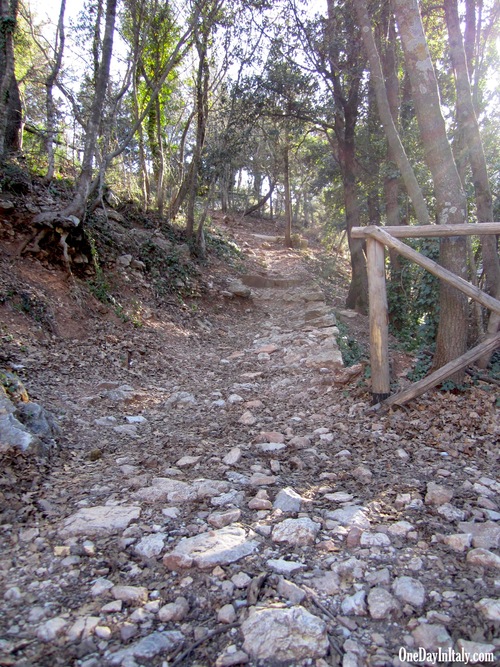
However, as I found out when I always tumbled down the steep shoulder of the path on several occasions, these shortcuts aren’t really maintained. The rocks are loose and liable to shift under your feet and the handrails are so loose in places that the deception of having it there is almost more dangerous. But I finally made it up to the entrance where a man with a beverage cart sold me a much-needed bottle of water and I glared at the people getting out of their cars bundled up in sweaters and well-rested. I think the man at the cart was laughing at me a little.
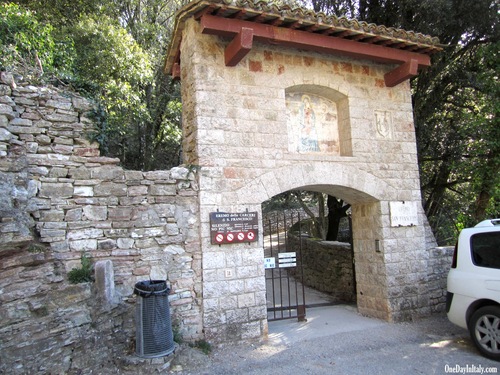
As you walk through the gate a statue of St. Frances greets you, but the hermitage isn’t readily visible.
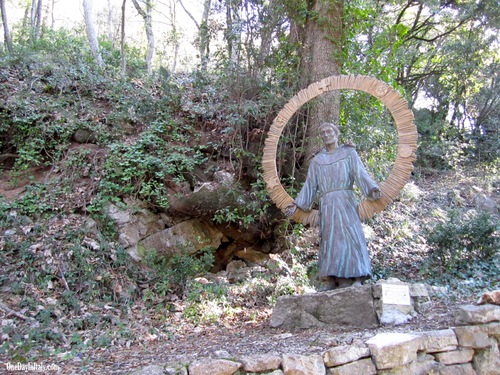
You walk to the right down a paved pathway that hugs the mountain (this one with a very sturdy stone wall on both sides).
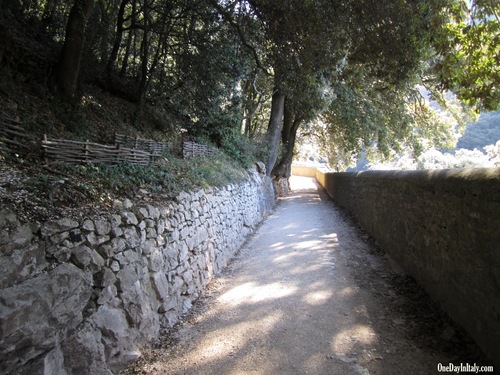
Turn the corner and the wall on your left extends father upward; you realize its now actually the side of a building. Still, there are no grand entrances, big signs or banners welcoming tourists. This is a place of simplicity, humbleness and tranquility.
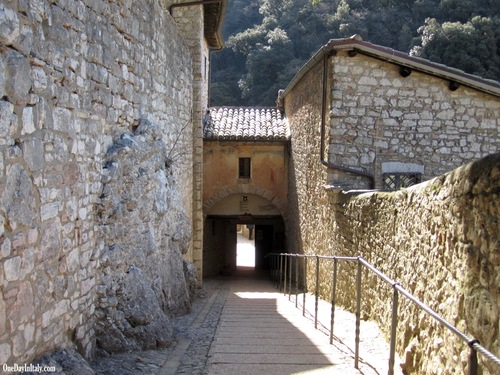
You walk through the portal into a small stone courtyard. To the right is the “office” and the entrance to a small chapel that overlooks the valley. The chapel is closed off to tourists and only open to those who wish to pray. I went to enter and was gratified that a nearby friar only pointed to the sign and nodded, eyebrows raised, to confirm I knew it was open for only prayer and contemplation, before releasing the stanchion and letting me in.
To the left of the entrance is a small refectory built by St. Bernardino of Siena around 1400AD.

A curved ceiling, simple wooden tables and a tile floor complete the room. One one end are a few decaying frescoes, and on the other end is a small altar. A simple, reverent common area for a simple, reverent community.
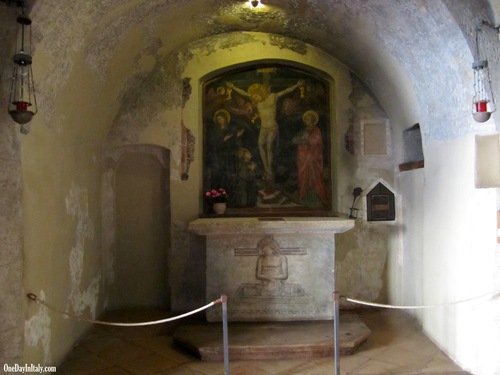
The area above the refectory is blocked off, and I can only imagine the cells (bedrooms) of the brothers and sisters who now live at and operate the hermitage are there. Currently there are four brothers of the Order of the Friars Minor (Franciscans) as well as a community of Missionary Poor Clares of the Holy Sacrament (Franciscan sisters) who have been given the charge of taking care of the sacred place and greeting the many pilgrims who seek out Eremo delle Carceri every season.
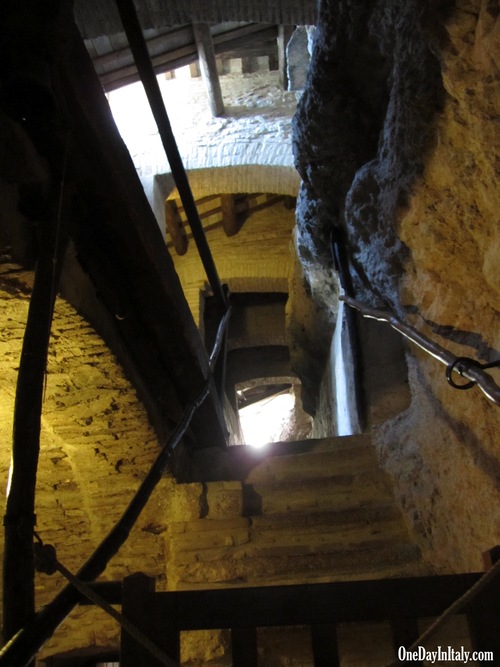
Back on the other side of the courtyard, I follow signs to the cave of St. Francis, but stop short when I enter a room and see only a tiny, narrow staircase leading down into a… hole. I have to duck under the arch before turning left into a small hallway.
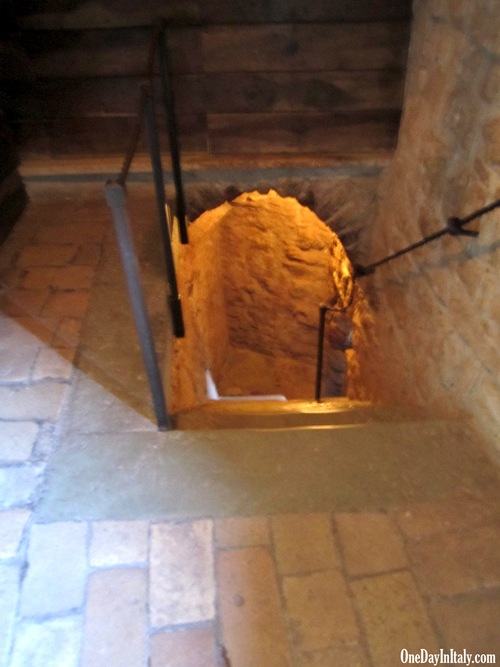
There’s a window looking out at the valley to the left which, before this infrastructure was here, would’ve been the view St. Francis gazed out upon from his cave. Directly in front of me is a wooden sign with painted white letters in three languages, in case you couldn’t figure it out from one or two of them, pointing to a small hole – not really a doorway – on the right and guiding you to the Cave of St. Francis.
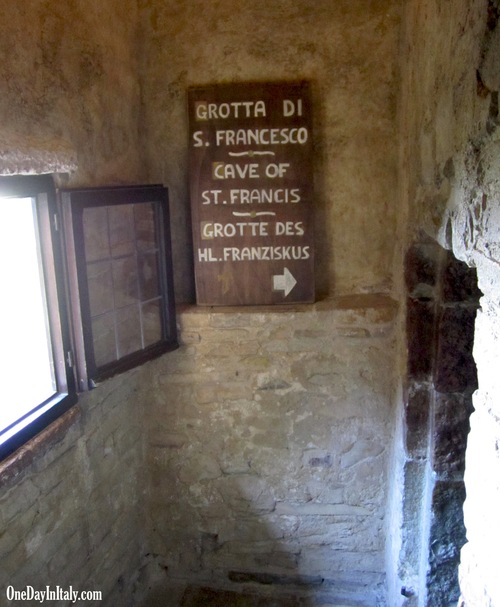
But don’t think you’re there yet! Or perhaps you are? It was a bit unclear to me whether this dark room with its natural stone walls was the exact space where St. Francis meditated, or whether it was the space through the narrow doorway on the other end. In this space there was a single flowering plant, perhaps symbolizing life blooming in the middle of a desolate space, so maybe this *is* the Cave of St. Francis.

At the time, though, I believed it was just through the doorway where the small, humble altar was set up with only a concrete table supporting a small but intricately carved crucifix.
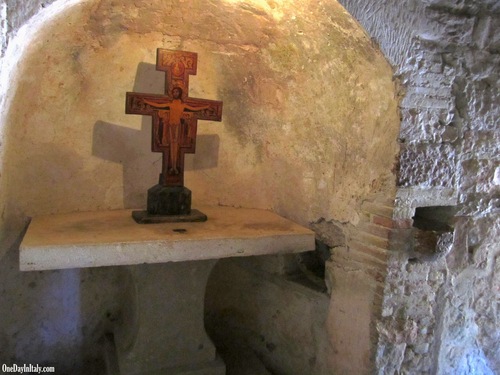
To the right of the altar (with all of these right turns we’ve now completed a full circle) is a narrow opening that leads back into a small courtyard, adjacent to the first. The picture I use as my profile picture on Facebook is an overexposed attempt at using my self-timer. It actually worked out below ![]()
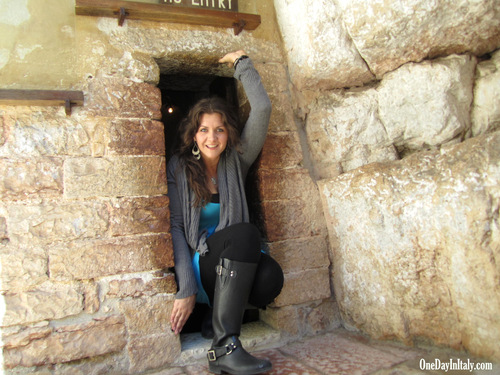
Once I squeezed myself out of the cave I walked the stone walkway away from the hermitage, not exactly sure what I would find.
What I now know I missed is the tree where St. Francis supposedly preached to the birds. It is at the end of the walkway and braced by metal crutches. The next time I’m there I’m definitely going to seek it out.
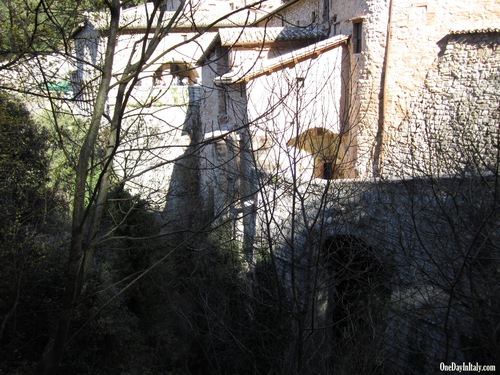
Hazzah! I found St. Francis laying on the ground, hands cradling his head, and two of his disciples appreciated the beauty of the nature around them.

A little farther on – not too far – I found this sign:
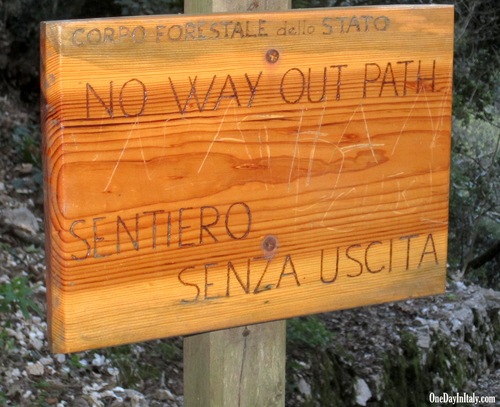
Perhaps this should’ve scared me – the “NO WAY OUT PATH”? – but it actually made me kind of excited. Who would’ve expected such a daunting phrase at a monastery?? Of course, now that I’m able to read the Italian I realize that the “daunting” quality of the phrase is probably a mistake. In Italian it says “Path Without Exit” which would be equivalent to our “No Outlet”, I suppose. But much more fun to think of it as “no way out!” ![]()
Stay tuned for the next post to see if I actually DO find a way out … dun dun dun…
Comments
comments












Leave a Reply